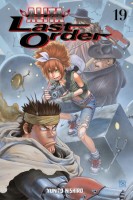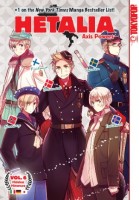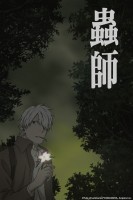My News and Reviews
Last week unintentionally turned into an Osamu Tezuka Week at Experiments in Manga…sort of. First of all, this month’s manga giveaway features Tezuka’s Triton of the Sea. Tell me a little about the merfolk you’ve encountered in manga for a chance to win the first omnibus of the series. (The winner will be selected and announced on Wednesday, so you still have a little time!) I also reviewed Dororo, Volume 3. Out of all of Tezuka’s manga that has so far been released in English, Dororo is one of my personal favorites. It’s currently available from Vertical in an omnibus edition which contains the entire series, however it may not be reprinted. I highly recommend picking up a copy sooner rather than later if it seems like a series you’d be interested in. And then for something completely different, over the weekend I reviewed the tenth-century classic The Tale of the Cavern (also known as The Tale of the Hollow Tree) which has absolutely nothing to do with Tezuka, but everything to do with music, love, and Heian-era court life.
In other news, the second volume of Lianne Sentar’s Tokyo Demons is now available for purchase as an ebook from the Sparkler Shop, which means the print edition will be released in the near future as well! (If you missed my early review of the novel, I loved it.) And speaking of Sparkler, the membership drive is still going on. If Sparkler Monthly doesn’t get at least 1,000 subscribers it most likely won’t be able to continue beyond its second year, which would make me extraordinarily sad. Please consider supporting Sparkler Monthly, if you can!
Elsewhere online, Shonen Jump is soliciting questions for Takeshi Obata, who will be a guest at New York Comic Con this year. If, like me, you can’t make it out to NYCC, Obata’s panel will thankfully be streamed live online. (Hopefully it will also be recorded.) In London, the Cartoon Museum is currently showing the exhibit Gekiga: Alternative Manga from Japan. To coincide with the exhibition, The Cartoonists’ Club of Great Britain wrote a brief introduction to gekiga. Finally, Vertical released a particularly interesting post on its Tumblr account about manga’s English-language market and specifically about the pricing of books.
Quick Takes
 Battle Angel Alita: Last Order, Volume 19 by Yukito Kishiro. Last Order was my introduction to the Battle Angel Alita universe. It’s probably best described as an alternate ending to the original series. While I was never as taken with Battle Angel Alita as much as other people seem to be, there were parts that I really enjoyed: interesting characters and character designs, martial arts, great action scenes, and so on. But the plot just never seemed to pull together in a way that satisfied me. I didn’t realize or expect that the nineteenth volume would be the final volume of Last Order. It’s also one of the most frustrating volumes as Kishiro seems to rush through the story in order to bring everything to some sort of conclusion and, in my opinion, fails to do so. Even more disappointing is the fact that Alita doesn’t even really make much of an appearance in it. Apparently there is yet another Battle Angel Alita series that will soon be starting in Japan, but I have no idea how it relates to Last Order. There was certainly enough left confused and unresolved in Last Order that there’s plenty of material for Kishiro to choose from.
Battle Angel Alita: Last Order, Volume 19 by Yukito Kishiro. Last Order was my introduction to the Battle Angel Alita universe. It’s probably best described as an alternate ending to the original series. While I was never as taken with Battle Angel Alita as much as other people seem to be, there were parts that I really enjoyed: interesting characters and character designs, martial arts, great action scenes, and so on. But the plot just never seemed to pull together in a way that satisfied me. I didn’t realize or expect that the nineteenth volume would be the final volume of Last Order. It’s also one of the most frustrating volumes as Kishiro seems to rush through the story in order to bring everything to some sort of conclusion and, in my opinion, fails to do so. Even more disappointing is the fact that Alita doesn’t even really make much of an appearance in it. Apparently there is yet another Battle Angel Alita series that will soon be starting in Japan, but I have no idea how it relates to Last Order. There was certainly enough left confused and unresolved in Last Order that there’s plenty of material for Kishiro to choose from.
 Devils and Realist, Volume 2 written by Madoka Takadono and illustrated by Utako Yukihiro. Although I mostly enjoyed the first volume of Devils and Realist, I was unsure how far I wanted to pursue the series and so decided to read at least one more volume. After reading the second installment, I can say that I’ll probably be reading even more of Devils and Realist in the future. Generally stronger than the first volume and more even in tone, the second volume takes a slightly more serious and dramatic turn. The series’ humor is still present though, interspersed among the more life-threatening events of the manga and the story’s other dangerous mysteries. Yukihiro’s artwork and character designs are very attractive, and as a whole there are some definite homoerotic undertones to the manga as well. Readers’ enjoyment of Devils and Realist will probably largely depend on how well they like the lead and his personality. I, for one, am greatly amused by William’s refusal to believe in the supernatural despite it staring him in the face as he stubbornly tries to come up with any other possible explanation for the strangeness going on in his life.
Devils and Realist, Volume 2 written by Madoka Takadono and illustrated by Utako Yukihiro. Although I mostly enjoyed the first volume of Devils and Realist, I was unsure how far I wanted to pursue the series and so decided to read at least one more volume. After reading the second installment, I can say that I’ll probably be reading even more of Devils and Realist in the future. Generally stronger than the first volume and more even in tone, the second volume takes a slightly more serious and dramatic turn. The series’ humor is still present though, interspersed among the more life-threatening events of the manga and the story’s other dangerous mysteries. Yukihiro’s artwork and character designs are very attractive, and as a whole there are some definite homoerotic undertones to the manga as well. Readers’ enjoyment of Devils and Realist will probably largely depend on how well they like the lead and his personality. I, for one, am greatly amused by William’s refusal to believe in the supernatural despite it staring him in the face as he stubbornly tries to come up with any other possible explanation for the strangeness going on in his life.
 Fairy Tail, Volumes 40-42 by Hiro Mashima. I’ve only read two series by Mashima—Fairy Tail and Monster Soul—but out of those two, I find that Fairy Tail is the better manga. The long Grand Magic Games tournament arc has now finally reached its conclusion with the fortieth volume. While I did find some of the Games enjoyable, for the most part I’m happy to be moving on to battles that actually have some real purpose and meaning behind them beyond securing bragging rights; I tend to enjoy Fairy Tail more when it feels like there’s something at stake. I’m glad to see the beginning of a new story arc that promises just that—things are starting to get a bit more serious again. (Granted, there was the whole dragon invasion during the Games arc; the possibility that the world will be destroyed is a pretty big deal.) It also looks like Gray will be getting some significant page time, too, which I’m not going to complain about. The Fairy Tail Guild’s latest mission requires Gray to confront his painful memories and past tragedies. It isn’t a pleasant experience for him, but he is also able to draw incredible strength from it.
Fairy Tail, Volumes 40-42 by Hiro Mashima. I’ve only read two series by Mashima—Fairy Tail and Monster Soul—but out of those two, I find that Fairy Tail is the better manga. The long Grand Magic Games tournament arc has now finally reached its conclusion with the fortieth volume. While I did find some of the Games enjoyable, for the most part I’m happy to be moving on to battles that actually have some real purpose and meaning behind them beyond securing bragging rights; I tend to enjoy Fairy Tail more when it feels like there’s something at stake. I’m glad to see the beginning of a new story arc that promises just that—things are starting to get a bit more serious again. (Granted, there was the whole dragon invasion during the Games arc; the possibility that the world will be destroyed is a pretty big deal.) It also looks like Gray will be getting some significant page time, too, which I’m not going to complain about. The Fairy Tail Guild’s latest mission requires Gray to confront his painful memories and past tragedies. It isn’t a pleasant experience for him, but he is also able to draw incredible strength from it.
 Hetalia: Axis Powers, Volume 6 by Hidekaz Himaruya. Perhaps by this point I should no longer be surprised, but I always seem to unexpectedly learn something new whenever I read Hetalia. Sometimes it’s a historical tidbit, and sometimes it’s actually something more closely related to current events. This particular volume of Hetalia features micronations and Molossia makes an appearance among several others. (I had never even heard of Molossia before, and it’s in Nevada!) The Nordic states are also an important part of the sixth volume, which includes Iceland. (Ever since writing a report on Iceland in the sixth grade, I’ve always been interested in and fond of the country, so I did get a kick out of that.) Often the humor in Hetalia does require some familiarity with or prior knowledge of world history and politics to really appreciate it, so in the process of trying to make sense of some of the jokes I find that I’m learning about all sorts of interesting things. Admittedly, Hetalia frequently makes use of stereotypes as part of its gags, which some people may find offensive and has generated a fair amount of controversy.
Hetalia: Axis Powers, Volume 6 by Hidekaz Himaruya. Perhaps by this point I should no longer be surprised, but I always seem to unexpectedly learn something new whenever I read Hetalia. Sometimes it’s a historical tidbit, and sometimes it’s actually something more closely related to current events. This particular volume of Hetalia features micronations and Molossia makes an appearance among several others. (I had never even heard of Molossia before, and it’s in Nevada!) The Nordic states are also an important part of the sixth volume, which includes Iceland. (Ever since writing a report on Iceland in the sixth grade, I’ve always been interested in and fond of the country, so I did get a kick out of that.) Often the humor in Hetalia does require some familiarity with or prior knowledge of world history and politics to really appreciate it, so in the process of trying to make sense of some of the jokes I find that I’m learning about all sorts of interesting things. Admittedly, Hetalia frequently makes use of stereotypes as part of its gags, which some people may find offensive and has generated a fair amount of controversy.











